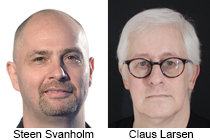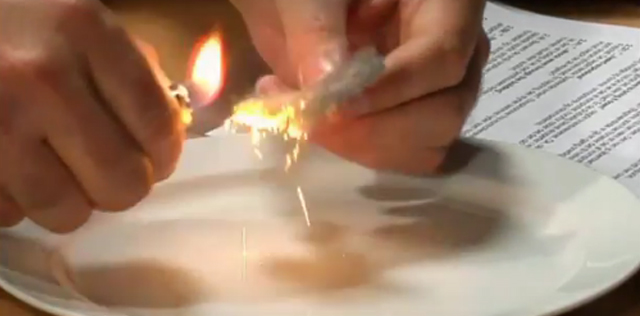Using 911facts.dk

How do you get the most out of this site?
Truth Movement
Publications
Booking

We are available for booking a lecture or a workshop here.

Ferrous spheres can only be due to thermite reaction

Claim
The claim is made by Thomas Nørgaard, physics teacher at Nørre Gymnasium, Copenhagen, on 911facts.dk’s Facebook page1:
“In Harrit et al’s article ‘Active Thermitic Material Discovered in Dust from the 9/11 World Trade Center Catastrophe’, the researchers perform DSC measurements. The residue in the calorimeter, after the red/grey chips have reacted, consists among other things of some microscopic ferrous spheres. The only physical/chemical process that can explain the formation of these ferrous spheres is a thermite reaction.”
“I Harrit et al. artikel ‘Active Thermitic Material Discovered in Dust from the 9/11 World Trade Center Catastrophe’ foretager forskerne DSC-målinger. Restproduktet i kalorimeteret efter de rød/grå-chips har reageret, er bla. nogle mikroskopiske jernholdige kugler. Den eneste fysiske/kemiske proces, der kan forklare dannelsen af disse jernholdige kugler, er en termitreaktion.”0
The claim is also made by Richard Gage, founder and president of AE911TRUTH.org and one of the leading figures in the Truth Movement.
Hardfire: Richard Gage & Mark Roberts
“There is no possible source for these iron-rich microspheres except for an aluminum-thermic reaction in an extremely pressurized condition…”2
(07:05)
Background
The claim is used to support the claim that huge quantities of explosives and top secret military-developed nanothermite were placed in the World Trade Center 1, 2, and 7 prior to September 11, 2001. When the nanothermite (and explosives) were ignited, the three buildings then collapsed.
Facts
Niels Harrit and his seven co-auhors mentioned in the claim3 have found some so-called “red/grey chips”, small flakes around 1 mm in size, in dust samples from the ruins of the World Trade Center complex. In an experiment, these chips are heated until they burst into fire at 430 degrees Celsius.
The authors then demonstrate that iron-rich microspheres are formed in the residue from the burning. They go on to claim that this is the result of a so-called thermite reaction, because one of the biproducts in a thermite reaction is elementary iron.
The authors continue to conclude that the chips must have reached very high degrees during the process, even if they ignite at 430 degrees Celsius, since the melting point of iron is far higher, around 1,500 degrees Celsius. However, it is not determined in the report just how high the temperature reaches during the process.
The physicist Dave Thomas has in an experiment demonstrated that iron-rich microspheres can be formed in other processes than a thermite reaction, e.g., when steel wool is ignited4. Thomas has even demonstrated, in a different experiment, that iron-rich microspheres also form when burning steel beams covered with anti-rust paint at temperatures well below the melting point of iron5.
One of the editors of 911facts.dk, Steen Svanholm, has on Fjord-TV, a local Danish television station, repeated Dave Thomas’ experiment of burning steel wool. The experiment also resulted in iron-rich microspheres6.
Additionally, Dr. James Millette has in 2012 replicated the central experiments in Niels Harrit et al’s report but has reached a different conclusion: That the red/grey chips are not nano-thermite7. Millette writes in his report that the iron spheres could be iron oxide. If the chips in question are nano-thermite, the combustion would result in elementary iron and not iron oxide.
Logic
It is a cardinal rule in science that you seek out other explanations than your own favorite one. The claim that ferrous spheres can only be formed by a thermite reaction does not take into account that there could be other explanations of the existence of spheres in the residue than a thermite reaction, which, as demonstrated in the above, there are. The claim is thus in violation of sound scientific practices.
It is an aggravating factor that Thomas Nørgaard is fully aware that the iron spheres possibly are iron oxide, since he has in-depth knowledge of Millette’s report:
“You write ‘The scientific rebuttal of the nano-thermite theory is here’. We might agree that that is an erroneous wording, since Millette’s article is merely a pdf on the Internet, which doesn’t live up to the fundamental demand of scientific work that it must undergo criticism and review by other scientists. It is a long time since he promised that he would publicize, and until now it has only been empty words on his part.”
“That Millette hasn’t even done any DSC-measurements, is outrageous.”
“Du skriver ‘Den videnskabelige tilbagevisning af nanothermit teorien er her’. Det kan vi nok blive enige om er en fejlformulering, da Millettes artikel blot er en pdf på nettet, som ikke lever op til det fundamentale krav til videnskabeligt arbejde, at det skal undergå kritik og eftersyn af andre videnskabsmænd. Det er meget lang tid siden, han lovede, at han ville publicere, og indtil videre har det kun været tom snak fra hans side.”
…
“At Millette ikke engang har lavet DSC-målinger, skriger til himlen.”8
Thus, Thomas Nørgaard is aware that, qua his professional background as a physics teacher at Ørestad Gymnasium that there is not merely one possible explanation.
Thomas Nørgaard is thus putting aside the principle of Ockham’s Razor9: If you have two or more explanations, you should choose the one with the fewest assumptions. This does not exclude that the rejected explanation at a later point can be the true one. It merely requires that more evidence can be found in favor of this explanation than the others.
The claim is based on outdated and rejected information. The report “Active Thermitic Material Discovered in Dust from the 9/11 World Trade Center Catastrophe” is from 2009, while both Dave Thomas’ experiment and James Millette’s report are more recent and easily available on the Internet.
The claim has thus been tested scientifically and found to be false.
Manipulation
Thomas Nørgaard manipulates by repeating and expand a rhetorical trick already present in Niels Harrit et al’s report, namely the concept of “iron-rich spheres”. It is highly doubtful that the microspheres can be described as elementary iron, since all samples show significant amounts of oxygen. In three out of five samples, even more oxygen than iron is present. It is more accurate to describe the spheres as iron oxide, a finding that Millette also confirms in his report. In other words, Niels Harrit et al’s report does not demonstrate elementary iron in the residue from the combustion process of the red/grey chips.
By calling the spheres “iron-rich”, you can interpret them as both spheres of elementary iron and spheres of iron oxide. Given that, it is manipulative to conclude that a thermite reaction has taken place resulting in elementary iron. Thomas Nørgaard expands the rhetorics by referring to the spheres as “ferrous”. This term is even more open to interpretation than “iron-rich”, since “iron-rich” at the very least means that a substantial amount of iron must be present in the spheres. “Ferrous” merely means that the amount of iron can be very tiny.
Conclusion
The claim is therefore:
- False
- Manipulating
Sources

- Lærerstab, Ørestad Gymnasium
- Hardfire: Richard Gage & Mark Roberts (04:00)
https://www.youtube.com/watch?v=45Imd5i7IGo - Active Thermitic Material Discovered in Dust from the 9/11 World Trade Center Catastrophe, Niels H. Harrit, Jeffrey Farrer, Steven E. Jones Kevin R. Ryan, Frank M. Legge, Daniel Farnsworth, Gregg Roberts, James R. Gourley and Bradley R. Larsen Pp 7-31
- Iron microspheres prove Thermite?
https://www.youtube.com/watch?v=jZ9wSD4Hcys - Burning Painted Steel Beams, Making Iron-Rich Microspheres!
https://www.youtube.com/watch?v=wLyYv5Y2YSM - Fjord-TV, del 2 (03:45)
https://www.youtube.com/watch?v=PrxF5vd0ZcE - Progress Report on the Analysis of Red/Gray Chips in WTC Dust, Revised Report of Results: MVA9119, James R. Millette
- Sådan svarer du en konspirationsteoretiker, Journalistisk Formidling
- Ockhams Ragekniv, Wikipedia
Q & A

